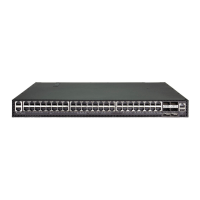C
HAPTER
17
| Multicast Filtering
Multicast VLAN Registration for IPv4
– 644 –
CONFIGURING
MVR DOMAIN
SETTINGS
Use the Multicast > MVR (Configure Domain) page to enable MVR globally
on the switch, and select the VLAN that will serve as the sole channel for
common multicast streams supported by the service provider.
CLI REFERENCES
◆ "MVR for IPv4" on page 1246
PARAMETERS
These parameters are displayed:
◆ Domain ID – An independent multicast domain. (Range: 1-5)
◆ MVR Status – When MVR is enabled on the switch, any multicast data
associated with an MVR group is sent from all designated source ports,
to all receiver ports that have registered to receive data from that
multicast group. (Default: Disabled)
◆ MVR VLAN – Identifier of the VLAN that serves as the channel for
streaming multicast services using MVR. MVR source ports should be
configured as members of the MVR VLAN (see "Adding Static Members
to VLANs" on page 200), but MVR receiver ports should not be
manually configured as members of this VLAN. (Default: 1)
◆ MVR Running Status – Indicates whether or not all necessary
conditions in the MVR environment are satisfied. Running status is
Active as long as MVR is enabled, the specified MVR VLAN exists, and a
source port with a valid link has been configured (see "Configuring MVR
Interface Status" on page 648).
◆ MVR Current Learned Groups – The number of MVR groups currently
assigned to this domain.
◆ Forwarding Priority – The CoS priority assigned to all multicast traffic
forwarded into this domain. (Range: 0-7, where 7 is the highest
priority)
This parameter can be used to set a high priority for low-latency
multicast traffic such as a video-conference, or to set a low priority for
normal multicast traffic not sensitive to latency.
◆ Upstream Source IP – The source IP address assigned to all MVR
control packets sent upstream on the specified domain. By default, all
MVR reports sent upstream use a null source IP address.

